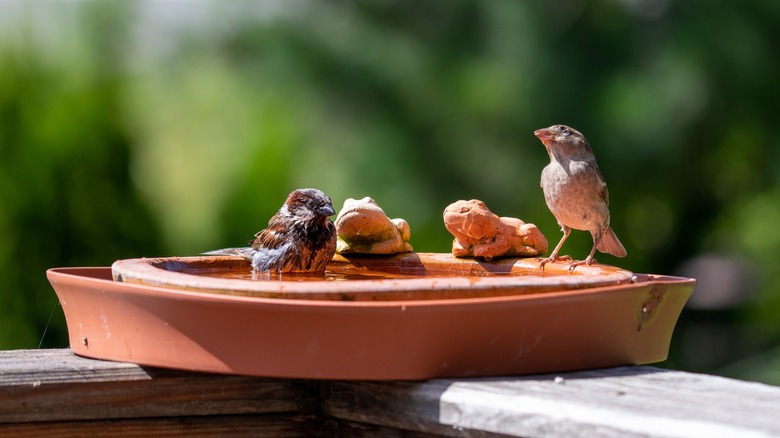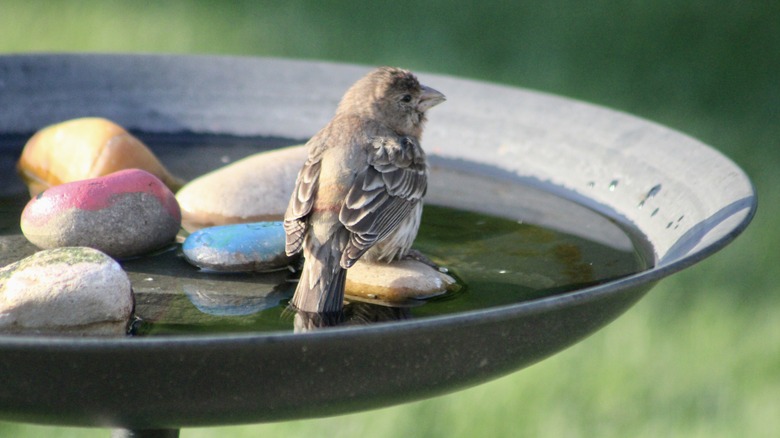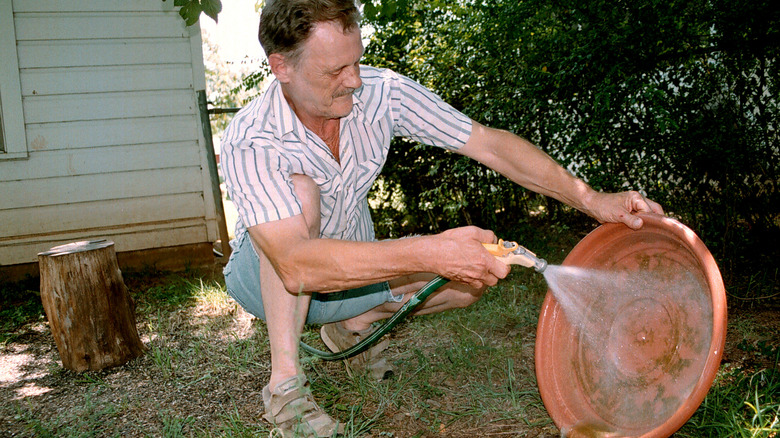Crucial Things To Consider Before DIYing A Bird Bath For Your Yard
There are plenty of unique ways to make a charming DIY bird bath that will attract beautiful fauna to your backyard. You can use a pretty terra cotta saucer, repurpose some gorgeous glassware, or easily create an incredible bird bath with a kitchen staple – a glass pot lid! Really, the sky's the limit, but there are also a few crucial things you'll need to consider before letting your imagination run free.
For one, while it's sure to entice pretty flying visitors, putting a bird bath in your yard may not always be the best idea. Not only might other critters, like squirrels and raccoons, visit the bath to drink from it, but mosquitoes are generally attracted to standing water. In order to keep them at bay, you'll need to be meticulous about upkeep, regularly cleaning the bath and replenishing its water.
If this sounds like something you're ready to do, you'll next need to check your backyard to see if there's a bird-friendly location for your DIY bird bath. The ideal spot will be shady, so the water doesn't become too hot to drink and doesn't evaporate quickly. Cool water will also detract insects from visiting. You'll also want to place it near greenery, as birds are more likely to use a bath surrounded by foliage. Once that's done, it's time to hone in on the appropriate materials, design, and maintenance.
How to DIY an attractive bird bath
If you want to maximize the number of feathery friends who visit your backyard, design is key. When choosing a material for your bird bath, you'll need something non-porous with a little bit of grip to make it easier to land on. Textured materials, like weathered glass, ceramics, and terra cotta are ideal. Stay away from metal, as this can become dangerously hot in the summer and may injure delicate bird feet.
Another important consideration is depth. The bath should be shallow enough for even the smallest birdies to enjoy safely. Ideally, select a vessel that's no more than 2 inches deep and fill it with 1 to 1 ½ inches of water. If you want to make it even more enticing, place a few stones or large glass pebbles inside to allow birds to confidently perch in the bath. As for diameter, the larger the better, so multiple birds can enjoy bathing at the same time.
One final consideration when crafting a DIY bird bath is whether or not to use a base. While some birds do like bathing at ground level, placing your bath 2 to 4 feet off the ground will actually make it safer, as it will stop many other creatures from getting inside. Not to mention, it will make for better bird watching. You can use a myriad of items — think tree stump, inverted flower pot, tomato cage — and, if needed, attach your basin with waterproof glue.
How to properly clean a bird bath
A clean bird bath is a healthy bird bath. When water is left sitting for too long, it can spawn bacteria, spur algae growth, and attract a growing number of mosquitos. The latter are drawn to stagnant water and can be dangerous to both birds and humans, as they spread serious diseases like the Zika virus. To avoid this, you'll need to commit to pouring out your bird bath's contents completely and refilling your basin with fresh water at least every other day.
You'll also want to regularly clean the basin. One genius trick to keep your bird bath clean is to scrub it with a mixture that's nine parts water to one part vinegar. Alternatively, you can also help your bird bath sparkle by cleaning it with baking soda. Simply mix the powder with just enough water to form a paste and spread it all around the bath, letting it sit for 15 minutes before scrubbing and rinsing. This will help keep it looking like new, plus, both vinegar and baking soda have disinfectant properties without being harmful to birds. On the flip side, there are some cleaning ingredients you should avoid using on your bird bath, namely store-bought chemical cleaners. These contain harsh elements that may cause birds and other animals to get sick.


